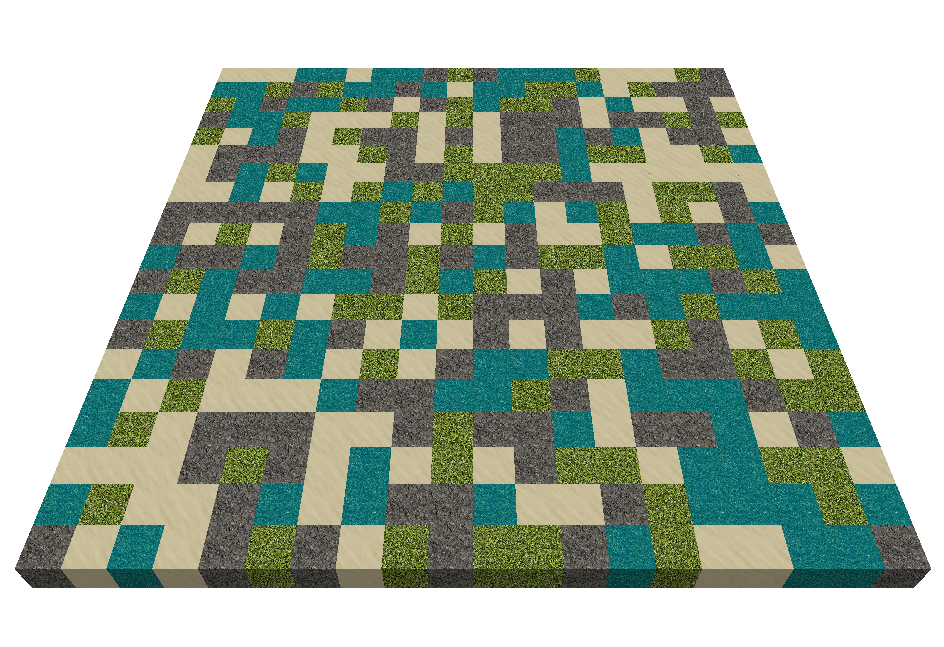adding some movement
The first thing I added was some basic movement. Ideally I would have liked this to be controlled largely by the mouse. However it's not immediately clear how to tie this in to the way that play-clj processes inputs. It would require locking the mouse cursor and making it invisible. Even using the java interop I couldn't tie this into the library. I've asked the question on the play-clj subreddit and I'll see if I get a response. For the moment I'm using the keyboard as an alternative.
key handler
Moving the camera with the keyboard is simple enough
:on-key-down
(fn [{:keys [key] :as screen} entities]
(condp = key
(key-code :w)
(translate-camera screen 0 0 -1)))We simply add a :on-key-down handler and take the keys from the screen map. The provided (key-code) function gives us a key that matches those in the keys map.
Translate camera is a simple function that moves the camera on the x, y and z axis before calling update on the perspective to 'commit' the changes.
(defn translate-camera
"Translate the camera on the x, y and z axis"
[screen x y z]
(doto screen
(perspective! :translate x y z)
(perspective! :update)))One small mistake I made here was to not return the entities from the :on-key-down handler. This resulted in my cube disappearing. My first thought was that I was moving the camera incorrectly and that I just couldn't see the cube any more. Eventually I realised that I was returning nil which was being interpreted as an empty list of entities.
textures
Next up was adding some texture to the cube. I ended up doing this with java interop as the support for adding textures to materials didn't seem to be present in play-clj (I may well be wrong about that).
(defn raw-texture
"Creates a libgdx texture from the supplied resourece path"
[path]
(-> path io/resource .toURI java.io.File. FileHandle. Texture.))
(def grass-texture (delay (raw-texture "grass.jpg")))
(defn random-texture
"Returns a random texture"
[]
(rand-nth [grass-texture stone-texture sand-texture water-texture]))
(defn block
"Creates a block at pos x, y, z with a random texture"
[x y z]
(let [texture-attr (TextureAttribute. TextureAttribute/Diffuse @(random-texture))
model-mat (material :set texture-attr)
...snip...raw-texture loads the file as a resource before creating a libgdx FileHandle which is passed to the texture.
Each texture is created as a delay as a texture can only be created inside a thread that contains the opengl context. This will be true when called from the gameloop but not when the code is evaluated. A delay solves this problem for us but does mean that we need to deref it to get the value.
Only a few changes are required to generate the block, we just have to create a texture attribute rather than a color attribute and add this when we create the material.
more blocks!
As you might be able to gather from the code above I addeda block function that creates a block when supplied some coordinates. I tied this into an extremely basic function that generates a 20 x 20 x 1 grid of blocks.
(defn blocks
"Creats a 1 deep plane of blocks from +20 to -20 on the x and z axis"
[]
(vec (for [x (range (- grid-size) grid-size 2)
z (range (- grid-size) grid-size 2)]
(block x 0 z))))how does it look?
Things are starting to look a touch more interesting now.
which tag?
Clone the repo and run:
git checkout tags/cube-grid
To see the code as it is right now
what's next?
World generation. I've decided to start looking into world generation a little first before tying the music into it. Hopefully that will be a little simpler than doing it in one pass.
